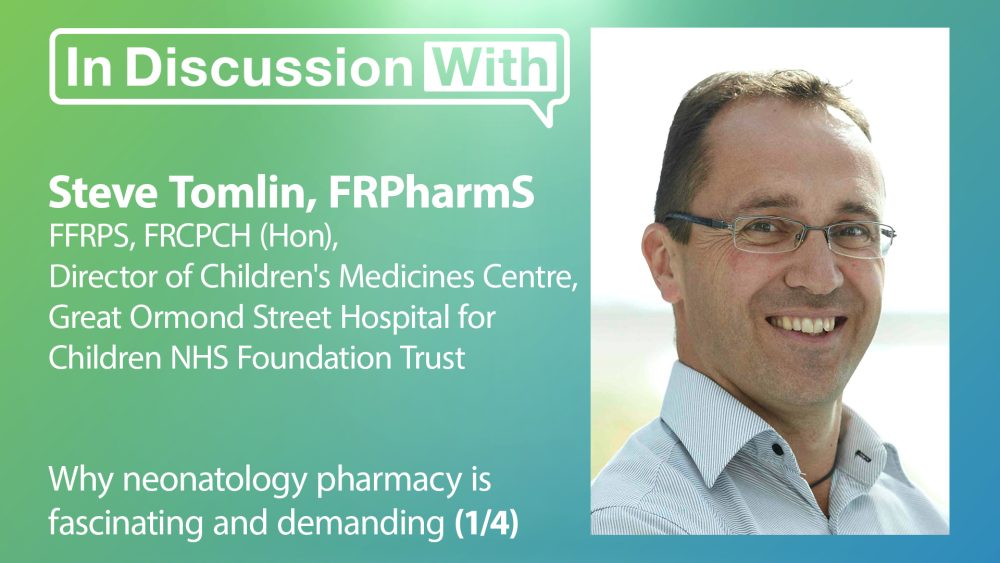Advertisment
Why neonatology pharmacy is fascinating and demanding

Steve Tomlin is a pharmacist and Director of the Children’s Medicines Research and Innovation Centre (CMRIC) at Great Ormond Street Hospital for Children in London. His mission is focused on improving children’s medicines and the way that they are used. IMI spoke to Mr Tomlin to find out more.
The role of the CMRIC is to bring people together to work on improving children’s medicines – making the most of the small number of specialists in children’s medicines across the country, explains Mr Tomlin.
Mr Tomlin’s interest in paediatric medicine started during his pre-registration training, part of which took place in a children’s hospital. At that stage many things in adult medicine were ‘black and white’ – “Here’s the answer. This is what you do. This is the dose”, but things were very different in paediatrics. “There was a little drawer on my boss’s desk …. and you just pulled out a card and it just had a drug name and a dose – no reference – and that’s how we practised. And it suddenly dawned on me how little we knew and therefore how exciting it was to be in a field where things were developing – and I think that’s what drew me into it”, he recalls.
At an early stage the death of an infant in a medicines-related incident underlined the importance of having sufficient information and a thorough understanding of the clinical situation. “A particular drug was wanted but that drug was needed in a particular salt. Nobody had picked up on the fact that the [available] salt was the problem. It was a theophyllinate salt as opposed to just an inert salt…….” he explains. The post-incident review raised a number of important questions – “We knew the drug but it did we know all the formulations of that drug? Did we know how to get that drug into the baby? What were we monitoring? ……… It just dawned on me how little we really knew and I think it was possibly one of the things which really drew me into thinking this is a career that I want to do, despite the fact that it was very nerve-wracking at the time”, he says.
Later in his career a fatal incident involving a contaminated parenteral nutrition solution further shaped his thinking. “You’ve got a baby still in the in the next bed – next to the baby who died – what do you say to the parents? I was more senior then. I was the lead of the department and [these are] really hard conversations to have but it really focuses your mind on how critical our roles are and how important it is to understand all of the implications of both the products [and] the way they’ve been manufactured.”
Such incidents made him think hard about how to use his knowledge to improve the working systems “and that’s … really been the focus of my career”, he reflects.
Neonatology
Neonatology has been the focal point of Mr Tomlin’s career. He explains the contrast with adult medicine: “It’s easy to give anybody one or two tablets, which is generally what the adult medicines are made up of. We count most adults as being the same size ……. we give one or two tablets to most adults. You can’t do that with neonates and I think it’s not just about the ….. dosing and the tablets. On the whole pharmacokinetics are similar in most people over the age of three years. …… It’s under three years when things really start to change with pharmacokinetics, blood-brain barriers, renal function, liver functions, the acidity of the gut [and] the gut motility. By the time you’re three years old most of those are very similar, although you don’t need the same dose because you’re not the same size, but the kinetics are very similar. But, under three years that starts changing – the smaller and smaller they get the more and more diverse that is. …. I think the thing that has really grabbed my career, I suppose, was premature babies because they’re not even supposed to be here …. they’re still supposed to be inside”, he explains.
“I’ve concentrated my career on paediatrics as a totality, [but] if somebody was going to ask me my love it would be neonatology because I just think I think it’s fascinating”, he concludes.
About Steve Tomlin
Steve Tomlin is Director of the Children’s Medicines Research and Innovation Centre (CMRIC) at Great Ormond Street Hospital for Children in London. He is also the professional lead of the Neonatal and Paediatric Pharmacists’ Group (NPPG) and the vice-chair of the Joint Medicines Committee at the Royal College of Paediatrics and Child Health (RCPCH)
The Children’s Medicines Research and Innovation Centre is concerned with advancing practice for children’s medicines both in terms of improving medicines themselves and improving the usage and effectiveness of medicines in practice.
Read and watch the full series on our website or on YouTube.
This episode of ‘In Discussion With’ is also on Spotify. Listen to the full podcast now.





